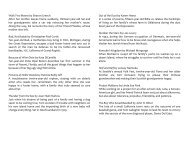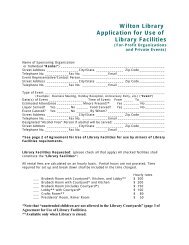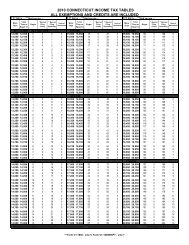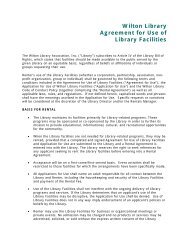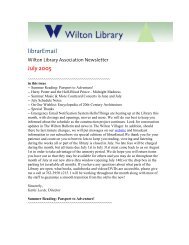CT-1040 Instructions, 2011 Connecticut Resident Income Tax - CT.gov
CT-1040 Instructions, 2011 Connecticut Resident Income Tax - CT.gov
CT-1040 Instructions, 2011 Connecticut Resident Income Tax - CT.gov
You also want an ePaper? Increase the reach of your titles
YUMPU automatically turns print PDFs into web optimized ePapers that Google loves.
columns, create a worksheet identical to Schedule 2 and attach<br />
it to the back of your Form <strong>CT</strong>-<strong>1040</strong>.<br />
If you are claiming credit for income taxes paid to another<br />
state and to one of its political subdivisions, follow these<br />
rules to determine your credit.<br />
A. If the same amount of income is taxed by both the city<br />
and state (see example for Line 56 on Page 29):<br />
1. Use only one column on Form <strong>CT</strong>-<strong>1040</strong>, Schedule 2,<br />
to calculate your credit;<br />
2. Enter the same income taxed by both city and state in<br />
that column on Schedule 2; and<br />
3. Combine the amounts of tax paid to the city and the<br />
state and enter the total on Line 57 of that column.<br />
B. If the amounts of income taxed by both the city and state<br />
are not the same:<br />
1. Use two columns on Form <strong>CT</strong>-<strong>1040</strong>, Schedule 2;<br />
2. Include only the same income taxed by both<br />
jurisdictions in the first column; and<br />
3. Include the excess income taxed by only one of the<br />
jurisdictions in the next column.<br />
Schedule 2 - Worksheet <strong>Instructions</strong><br />
Complete the Schedule 2 Worksheet to determine the portion<br />
of your <strong>Connecticut</strong> adjusted gross income derived from a<br />
qualifying jurisdiction. For each line in Column II, enter the<br />
items of income from Column I that meet all of the following<br />
conditions listed below.<br />
• The income is derived from or connected with sources<br />
within a qualifying jurisdiction;<br />
• The income is reported on an income tax return filed with<br />
that qualifying jurisdiction and subject to income tax in<br />
the jurisdiction; and<br />
• You have paid income tax on the income to that qualifying<br />
jurisdiction.<br />
If you paid income tax to more than one qualifying<br />
jurisdiction, you must complete a separate worksheet for each<br />
jurisdiction. Keep the worksheet with your <strong>2011</strong> tax records.<br />
Do not attach it to your tax return.<br />
The federal income tax return line references are to the federal<br />
Form <strong>1040</strong>. If you file a federal Form <strong>1040</strong>A or federal Form<br />
<strong>1040</strong>EZ, use the appropriate lines from those forms.<br />
Column I<br />
Enter on Lines 1 through 15 of the worksheet the amounts<br />
entered on Lines 7 through 21, respectively, of your federal<br />
income tax return.<br />
Enter on Line 17 of the worksheet the amount entered on<br />
Line 36 of your federal income tax return.<br />
Enter on Line 19 of the worksheet the net amount of<br />
your <strong>Connecticut</strong> modifications to federal adjusted gross<br />
income. Subtract Form <strong>CT</strong>-<strong>1040</strong>, Schedule 1, Line 50, from<br />
Line 39 to arrive at this amount.<br />
Column II<br />
For each line, enter that portion of the amount entered on<br />
the same line of Column I you reported on an income tax<br />
return filed with (and on which income tax was paid to) the<br />
qualifying jurisdiction. On Line 17, enter only the portion of<br />
the total federal adjustments to income directly related to<br />
income sourced in the qualifying jurisdiction. On Line 19,<br />
enter only the portion of <strong>Connecticut</strong> modifications directly<br />
related to income sourced in the qualifying jurisdiction. The<br />
fact that the qualifying jurisdiction may take into account your<br />
entire adjusted gross income (to compute the rate at which<br />
your income sourced in that jurisdiction will be taxed) does<br />
not mean you paid income tax to that jurisdiction on your<br />
entire adjusted gross income. Because you are a nonresident<br />
of the qualifying jurisdiction, you may be taxed by that<br />
jurisdiction only on your income sourced in that jurisdiction.<br />
Example 1: Amy, a <strong>Connecticut</strong> resident whose filing status is<br />
single, earned wages of $150,000 from a company located in the<br />
State of New York. Amy works inside and outside of New York<br />
and allocated her wage income based upon the days worked in<br />
New York. She determined $100,000 to be her New York State<br />
allocated wage income and reported and paid this amount on<br />
her New York nonresident income tax return. On her federal<br />
Form <strong>1040</strong>, Line 7, she entered $150,000. When completing<br />
the Schedule 2 Worksheet, she enters $150,000 in Column I,<br />
Line 1, and $100,000 in Column II, Line 1. Amy also enters<br />
$100,000 on Form <strong>CT</strong>-<strong>1040</strong>, Schedule 2, Line 53.<br />
Example 2: Luke and Lee file a joint federal Form <strong>1040</strong> and a<br />
joint Form <strong>CT</strong>-<strong>1040</strong>. Lee’s wages as an employee working in<br />
Rhode Island are $20,000 and Luke’s wages as an employee<br />
working in <strong>Connecticut</strong> are $25,000. On their federal<br />
Form <strong>1040</strong>, Line 7, they enter $45,000. When completing<br />
the Schedule 2 Worksheet, Luke and Lee enter $45,000 in<br />
Column I, Line 1, and $20,000 in Column II, Line 1. Luke and<br />
Lee also enter $20,000 on Form <strong>CT</strong>-<strong>1040</strong>, Schedule 2, Line 53.<br />
Example 3: Linda is a sole proprietor of a business<br />
conducted at two locations: one in <strong>Connecticut</strong> and one in<br />
Massachusetts. On Linda’s federal Form <strong>1040</strong>, Line 12, she<br />
entered $100,000. Of the $150,000 of gross income reported on<br />
federal Form <strong>1040</strong>, Schedule C, $90,000 is derived<br />
from the Massachusetts location. Of the $50,000 of<br />
expenses reported on Schedule C, $35,000 is derived<br />
from the Massachusetts location. When completing<br />
the Schedule 2 Worksheet, Linda enters $100,000 in<br />
Column I, Line 6, and $55,000 ($90,000 - $35,000) in<br />
Column II, Line 6. Linda also enters $55,000 on Form <strong>CT</strong>-<strong>1040</strong>,<br />
Schedule 2, Line 53.<br />
Page 27





